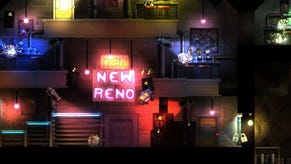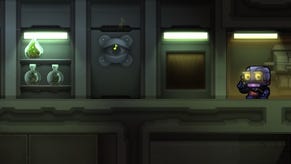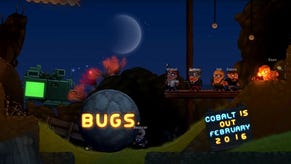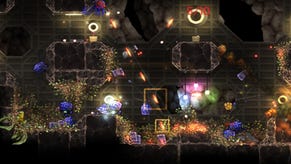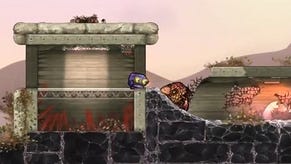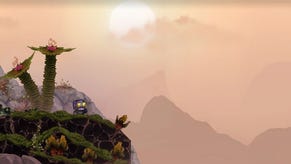Minecraft Devs Mojang To Publish Cobalt
And we've interviewed the developers
Here's some news. Mojang, the creators of Minecraft, are expanding from being developers, to also being third-party publishers. And the first to appear through the company is action game Cobalt, by indies Oxeye Game Studios. What is it? We've tracked down the team and asked them all about the game, and how the deal came about. And how they might put teabagging in the game.
Going into publishing was always part of the plan. Mojang's Carl Manneh explains that from the beginning of the development studio being set up they had intended to collaborate with other indie developers. Of the right sort. "We wanted to find studios who have our philosophy of developing games, which is staying close to the community and treating it as a service."
Oxeye is somewhat related to Mojang. Founded by Mojang member Jens Bergensten, and Daniel Brynolf and Pontus Hammarberg (Swedes get all the best names), it also has music by Mattias Häggström, who is behind the tunes in Scrolls. The relationship is such that the team have been spending a few months working in the Mojang HQ.
So what is Cobalt?
"It’s hard to be a metal face," explains the information we've been given.
"Agent Cobalt has learned as much after finding the Space Exploration Foundation’s lost colonization ship The Seed at planet X9CSEC5.5B-blue, Trunkopia. It was once built by a one million strong development team back on Earth, but disappeared merely 30 minutes after its subspace jump. Whatever happened on board during its misadventure, sanity was not invited."
So what manner of game? It seems the umbrella of "action" is probably easiest, bearing in mind the game involves (deep breath):
"Running, jumping, rolling, shooting, throwing, dancing, hacking, rolling, flying, sliding, climbing, looting, deflecting, racing, piñata-ing, passing, scoring... and even more rolling!"
Well that's not enough information for the likes of us, so I tracked down Daniel Brynolf to find out a lot more.
RPS: Can you tell us how did the idea for Cobalt begin?
Daniel Brynolf: It began about two years ago when we were sitting at home contemplating the demise of our company, Oxeye Games Studio. Basically, we had to come up with something, or we would shut it down and move on. Kinten reminded me of an old prototype I had made sometime during 2001, which we had come to revisit a couple of times over the years. We both agreed that it was a cute game with an interesting feel, and we wondered what could happen if you took that concept and scaled it up into a full game. So we called Jeb and we discussed it, and after one weekend of work we had a first hi-res prototype with a robot running around on platforms and rolling. All we knew back then was that it was going to be focused on having a kick ass platform movement...
RPS: What will we be doing as a tiny robot?
Daniel Brynolf: It plays not so much like a platformer, which I guess is strange. We have very few "platforming" challenges in the game. Instead we have focused on a very action oriented flow where you move from one crazy situation to the next. Commonly, you could run into a situation, someone would throw a grenade at you, game turns into slow motion as the danger looms closer, you would pull up your fist, charge it, auto aim at the grenade as it comes closer, and whop it so that it flies away as you right after switch to some gun and moves into a roll which turns you around 360 degrees allowing you to aim at the robot that threw the grenade, and pop its head with a well timed shot. Stuff like that. The bigger picture would be that you do these kinds of things in various levels and gamemodes, both versus and cooperatively in some sort of challenge.
RPS: That sounds complicated - how have you managed to get slo-mo to work in multiplayer?
Daniel Brynolf: Slow motion is local to the things around the players that are exposed to danger, so one person on the edge of the level can run just fine, while two other players might be in the middle of a matrix-esque duel. If the third player would approach the two players, or throw a grenade into the mix from afar, the approaching objects get increasingly slowed. We were pondering for a long time how exactly to solve this, and there were lots of fears about things that could go wrong in the design. But so far, during testing its been working out perfectly. When you are the creator of the slow motion (you are in danger), you are only slowed 90% of the effect, which in practice gives you "more" time than you would have had in normal speed.
RPS: It sounds mind-boggling! So what role does dancing play in all this?
Daniel Brynolf: Dancing came about as we were moving around with the character, and we realized it was quite fun just exploring the different moves. So we got the idea to register each move you did, and match it to the beat of a song playing. We then registered the moves in pairs of four as you were "dancing", and by not repeating the same four-pattern during the dance, you would increase the "dance" level. The idea was to use it for say, gaining entrance to a "secret dance club" in a city. However, we have not actually put this to use yet. Currently the spirit of dancing lives on in the movement. But the dancing game is still in there, and I sometimes think about it. It would be cool with a dance-off game mode.
RPS: That seems essential!
Daniel Brynolf: Now that I think about it, maybe it could be added Cobalt's version of teabagging. Where if you stand on someone's corpse and pull of a level 5 dance, you get an extra point!
RPS: Er, moving on… Piñatas?
Daniel Brynolf: Piñatas might not be as colourful as it sounds. It originates from an interview with the lead designer for Diablo II, where he sort of explained what he thought made D2 fun. One of the things he was emphasizing was the piñata effect of slaying mobs, where the items would burst out and fly through the air and landing with a satisfying sound. This is something we have taken very seriously in Cobalt.
RPS: Will the game have a single player component?
Daniel Brynolf: The game started out a heavily story driven campaign game, lacking multiplayer what so ever. During this last half year or so, we have changed direction and are now focusing on multiplayer, including cooperative play. So I guess you could claim there is no dedicated single-player campaign planned now. But we are including the map editor in the game and the game supports campaignish content. So this we hope is something we could develop together with our hopefully future community.
RPS: What happened to all those single-player ideas?
Daniel Brynolf: They live on in the cooperative side of things
RPS: Ah, so the co-op is separate from the multiplayer?
Daniel Brynolf: Yes. There are versus game modes you can play with friends, or you can team up against bots in the very same game modes. But the co-op is something else entirely. It is the past single-player experience, but focused more towards cooperative replayability than tens of hours of story driven content.
RPS: So how did the thing with Mojang come about?
Daniel Brynolf: Well, during the time Cobalt started, it was mostly me that had the time to do it, So I’ve been the only one working full time on it since the start, with Kinten and Jeb helping out as much as they can. Kinten was studying to be a doctor and Jeb worked at various tech companies until he finally landed at Mojang. This led to me and Kinten often visiting and hanging out at the office and also hanging out a lot with the Mojang people in general. I'm not sure exactly sure how the next step came about, but one day they invited us out to dinner and asked if we would like to collaborate. Basically, they loved Jeb, and they really liked the look of Cobalt, and we really enjoyed working together already. So it was quite natural. We had met some of the guys prior to the success of Minecraft as well, so it felt like we were experiencing the whole shift together in a way.
RPS: What is the deal you've worked out with them? Is Notch taking all your profits to build another wing onto his platinum palace?
Daniel Brynolf: Notch is not taking all our profits! Any profit sharing you are referring to will be with Mojang which shockingly is really a bunch of nice people who enjoy to make games. Its a win-win deal. They wanted another game to put their time and efforts into, we, Oxeye, are really good at core game development but really bad at doing everything else. This was a very good fit both for us, for the project, and for Mojang. Mojang grew very fast, and because of that, they have a good range of talented individuals whose focus is not only core game development. I think they needed another project to sink their teeth in, since the tasks needed for each game project very much varies over time. And we really needed someone to sink their teeth into ours.
RPS: So would you recommend this route to other indies?
Daniel Brynolf: I'm not sure it’s a route at all. I mean, its a very special situation, both for us and for them. It’s not like there is a form to fill out! But I guess if I were to imagine this being a standardized route indies could take, then of course. It’s good for us, it’s good for them, it’s good for the project. It’s a symbiosis, where neither of us has to give anything up really, so yes, I would. But I don't think its something you actively hunt for. It sort of emerges naturally if there is such an opportunity.
RPS: What is it they offer that you don't think your team could do? Other than free drinks on Friday.
Daniel Brynolf: It’s hard to answer because they offer us things on so many areas, but give or take: their name, their contacts, the people working at Mojang, their offices, their expertise, their attendance to events, their payment system, their account-system and so on. I mean, it’s basically a fully dynamic collaboration. Also, their incredibly comfortable sofa in the gaming room to sleep on.
RPS: Do you know when the game might be coming out?
Daniel Brynolf: Our plan is to have an alpha or something like that by the end of the year.
RPS: Ah, so you'll release on the same model as Minecraft, a purchaseable alpha?
Daniel Brynolf: That’s the general idea. We really liked that model, so why not.
RPS: One other thing.
Daniel Brynolf: Yes?
RPS: Could you beat Notch up until he releases mod support for Minecraft? Really, really hurt him. Kick his shins, pull his hair.
Daniel Brynolf: Actually, we haven’t really reached the "comfortably-hugging" state just yet, so I don’t know how down with I would be about hurting him. I did own his ass on Counter-Strike: Source though, if that is of any help. But I'll probably have to eat up those words later on as he gibs me in Q3 some day…
RPS: Awesome, thanks so much for chatting.
Daniel Brynolf: Thanks John for your time!
RPS: That's our line!









